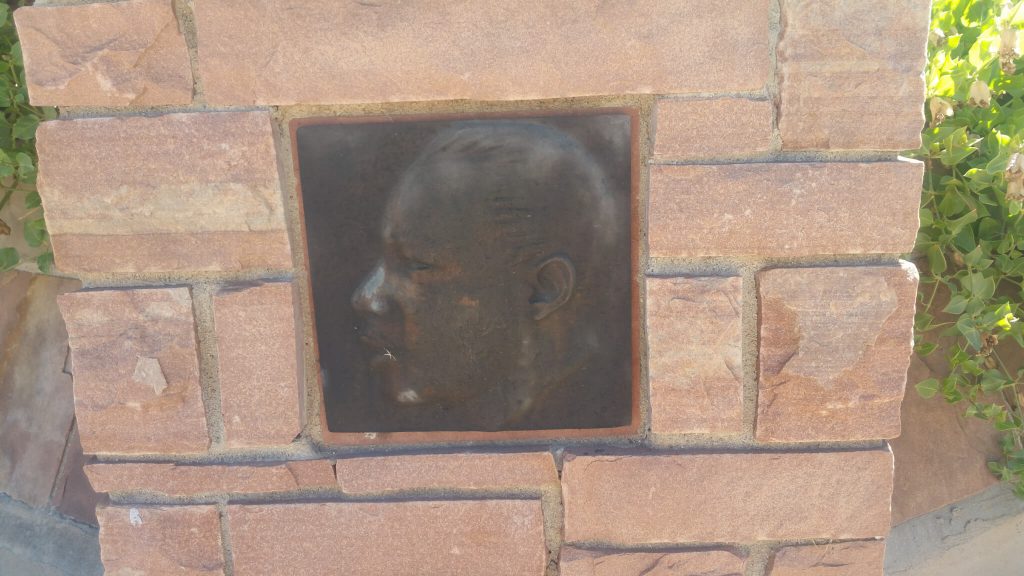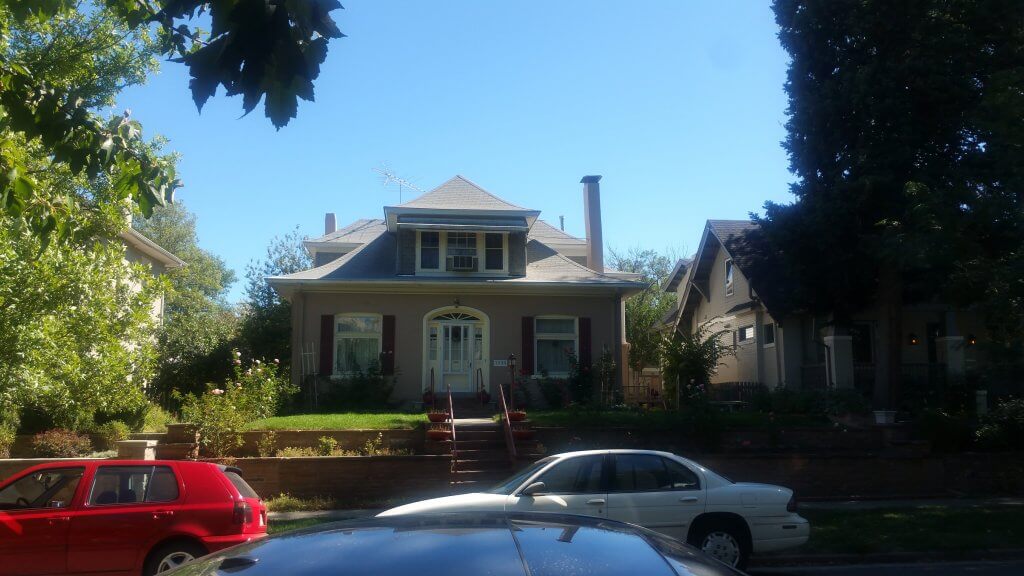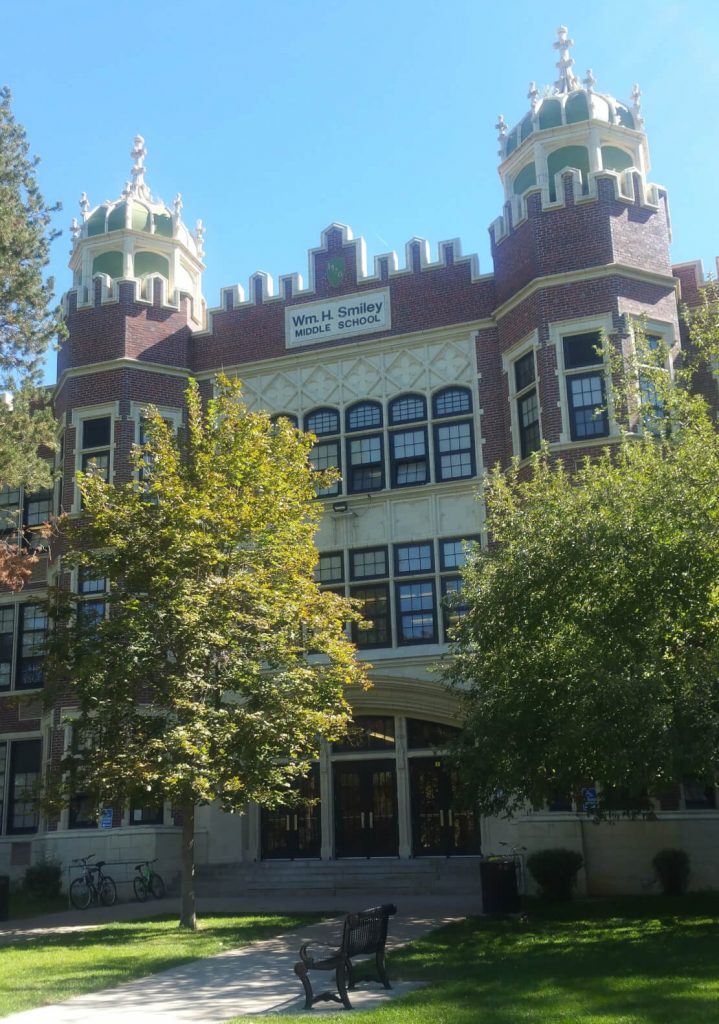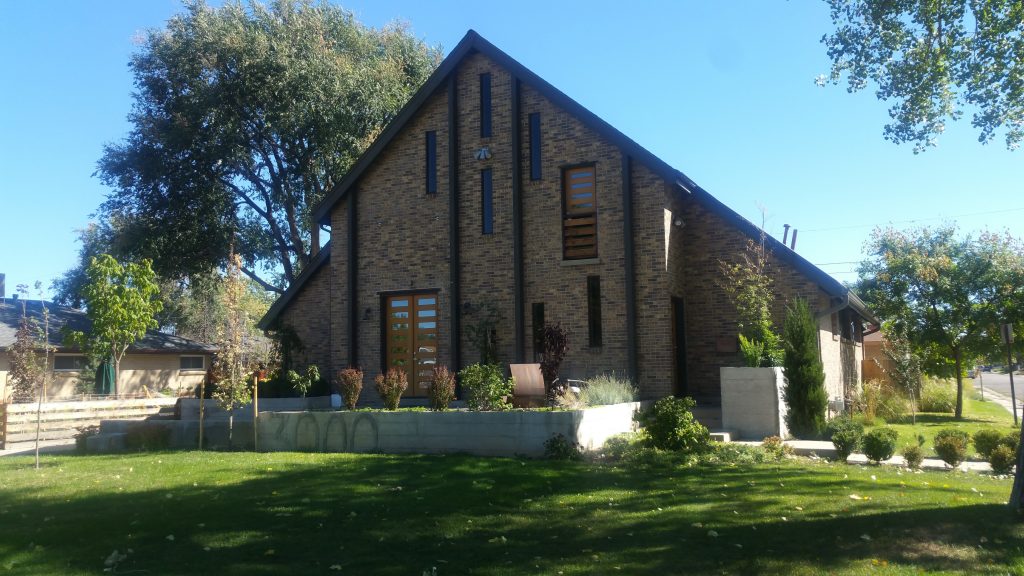An Urban Hike through Denver’s Conflicted Affair with MLK, Race Relations, and the KKK

Martin Luther King, Jr’s facade appears on each crossing on MLK Jr Blvd.
Park Hill’s giant footprint to the east of City Park is actually divided into three “official” neighborhoods according to the City of Denver. For this walk you will amble through two of the three “neighborhoods”, North Park Hill and Northeast Park Hill.
*editorial note: Please note that there is no agenda here to separate the neighborhoods by this route. The geography of “Park Hill” is too big to do in one day. If you would also like to walk the southern portion known as South Park Hill, please read this post with its curated map. You might also want to read this piece about Park Hill’s History before taking off, as the info below just barely scratches its surface.

From small bungalows to fancy cottages, the architecture throughout Park Hill varies.
Where Is Park Hill?
Northeast Park Hill is directly north of North Park Hill with the same east-west boundaries of Colorado and Quebec. Northeast Park Hill extends above I70 to 56th Ave, stopping at North Park Hill’s northern boundary of Martin Luther King, Jr, Blvd. North Park Hill then continues south to E 23rd Ave.

A variety of homes throughout North and Northeast Park HIll
It’s a big neighborhood with a big story. Fashioned out of the prairies and farms east of City Park, the neighborhood grew northerly, eventually taking over the original Lowry Field. Barons von Winckler and von Richthofen played a part in establishing Park Hill, and their story fits better in discussing south Park Hill and Montclair.
A Segregation Story Starts Here (but Doesn’t End.)
Park Hill’s neighborhoods tell the a story that keeps unfolding through the names of its streets, parks, schools and churches, and continues to be told through annual MLK Marades, festivals, and daily activities.

Smiley school building
The schools in Park Hill, particularly Barrett and Park Hill Elementary, were the center of a segregation battle that started with Park Hill plaintiffs battling Denver Public Schools. With a case that rose up to the Supreme Court (Keyes v School District 1 Denver), DPS was eventually told to enforce bussing in an attempt to desegregate Denver schools. This decision led the way to national bussing changes in every school district in the country.
MLK, Jr in Park Hill
Martin Luther King, Jr visited Park Hill in 1964, making visits and speeches at Macedonia Baptist Church and then spoke at Montview Boulevard Presbyterian Church. Crowds overflowed the churches, spilling into the streets of Park Hill. King chose Park Hill because of the Park Hill’s community vision to integrate peacefully and its history in the fight for integrated schools.

Although City Park is not in the Park Hill neighborhood, while walking this route, it’s important to remember that in City Park is a statue of MLK, Jr. In 1976, Ed Rose took up the challenge of sculpting Martin Luther King, Jr. Many felt that the squat figure of King with Emmett Till, the Mississippi youth whose lynching prompted King into the civil rights movement, should have been more lifelike and not so representative.
The Martin Luther King Jr Memorial Foundation had commissioned the statue and felt the head was too large for the body. Although Rose was finally paid, the statue was moved to the Denver Art Museum’s basement in 1976 and in 2002, it was moved to the Martin Luther King Jr Museum and Cultural Center in Pueblo. A second statue, fashioned by Ed Dwight replaced the original in 2002, and it now stands. It includes King, standing on the shoulders of Mohandas Gandhi, Rosa Parks, Sojourner Truth and Frederick Douglass. Surrounding the statue on the plaza, you’ll find panels depicting relevant moments in civil rights history.
An Historic Home Still Impacts Park Hill Today
As you’re walking the route below, notice the house on the corner of 26th Ave and Clermont (4431 E 26th Ave, Denver). This is the home of an anti-KKK advocate, an original Colorado Mountaineer, and a land developer and Tuberculosis healer. Read the story here.
And Finally, New Areas Making Impact in Park Hill Today

Dahlia Campus for Health and Well-Being – Mental Health Center of Denver
The Dahlia Campus for Health and Well-Being has become a centerpiece of Park Hill. Opening its doors to those who need health care, dental care and community care, the Dahlia Campus also offers urban gardening, cooking workshops, and even a fishery!
The walk (see route below) will take you past some of the relevant points of interest, while also enjoying the diversity and community of Park Hill. You might want to reference The Park Hill Neighborhood by Thomas Noel and William Hansen to guide you in your turns.
The Route
Start at 3800 Dahlia Street. Walk east on 38th Ave, stopping in Commonwealth Coffee Roasters for a quick cuppa or a sniff of the roasted coffee. Turn left (north) on Forest and stop in at Mountain Fresh Market to grab a snack. Once you’re caffeinated and filled, head east on E 38th Ave to Hudson, turn right.
Continue on Hudson to 37th Ave, then take a right on Holly.
Pass the Hiawatha Davis Rec Center (named after a former City Council member and activist in the black community), taking a left on 33rd Ave.
Take a right on Ivanhoe to MLK, Jr. Turn right to cross over MLK, Jr at Holly. In the median, be sure to notice the brass facades of MLK, Jr in the brick planters. Continue down Holly to 30th, take a left.
Take a right on Ivanhoe. As you approach Smiley campus, you’ll be walking the block where the head plaintiff in the DPS desegregation/bussing case’s home was bombed. At E 26th, turn right.
The Smiley campus, first named Holly Junior High and then Park Hill Junior High, became the first Junior High in Denver to integrate. The campus is named after William Smiley, a popular DPS Superintendent from 1912-1924.
At Holly, go south. Notice the green terra-cotta tiles capping the domes of the school. At E 25th Ave, take a right.
Take a left on Grape Street and then a right on E 23rd Ave. Cross Elm, and notice the home at 4935 E 23rd Ave, the Johnson/Turnbull house. Built in 1908, this Arts and Crafts home also provided materials for the owner’s daughter’s home just north on Elm at 2315. Johnson was President of a men’s furnishing business and Turnbull pioneered film-making animation here in Colorado.
Go north on Elm. Take a right on E 25th Ave and then a left on Fairfax. Take a left on 26th, then a right on Clermont.
Cross MLK, Jr, and enter the City of Axum Sister City Park. One of several Denver Sister City Parks, this park mirrors its sister in Axum, Ethiopia, birthplace of the Queen of Sheba.
Exit the park to the east along E 33rd Ave, turning north (left) on Dahlia. At the Dahlia Campus for Health and Well-Being – Mental Health Center of Denver, enter the gardens on the east side of the building and enjoy the community gardens and hydroponic fish tanks.
Continue north on Dahlia to return back to where you started.
Click here to see the route, map, and turn by turn directions.
Walking Park Hill and Supporting Denver By Foot
If you’ve enjoyed this walk, maybe you’ll enjoy some other walks curated by Denver By Foot.
Thank you so much!
Did you enjoy this walk? What was the best part? Post your comments below and follow us on Instagram and Facebook to keep updated with new hikes and adventures.
~See you on the trail
Chris


Very fun walk. Couple of suggestions. The Mountain Fresh Marker is more logically located after the the Commonwealth Coffee Roasters. Also, it would be fun to add a cool used bookstore to the route. There is one on 4620 E. 23rd (just east of Dexter). Here is the link https://nam02.safelinks.protection.outlook.com/?url=https%3A%2F%2Fparkhillcommunityb.wixsite.com%2Fbooks&data=02%7C01%7Cjkpetit%40msn.com%7Ca70b300736ff4447612f08d530400bd8%7C84df9e7fe9f640afb435aaaaaaaaaaaa%7C1%7C0%7C636467973986279078&sdata=i6OcKBS1pBuiRp8QexOLQQMU8MoD01%2FWXiRXxaZbsaU%3D&reserved=0
Thank you so much for the suggestions! Yes, I agree on your re-routing! Good suggestion.
I love that bookstore! I got my copy of The Park Hill Neighborhood there, which I used for both this route and the South Park Hill route. Than you!